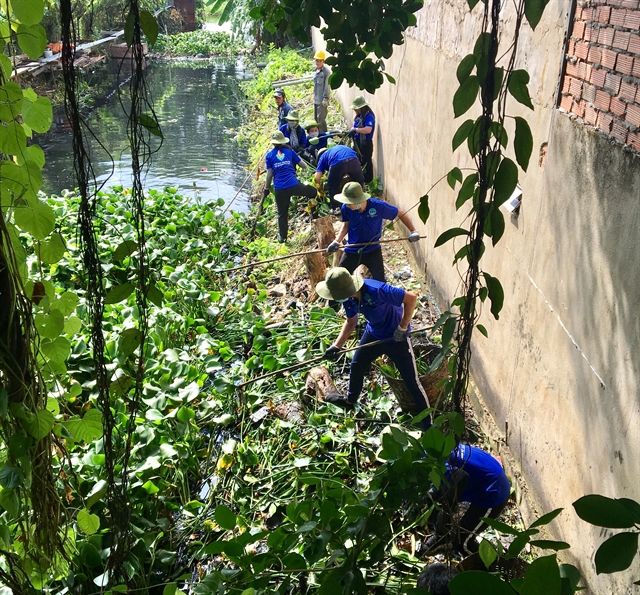 Environment
Environment

Greater public awareness and action, especially in classifying garbage at source, is a breakthrough that HCM City will build on to environment quality in the coming decade.

|
| Volunteers clean up the Bà Lựu Canal in HCM City’s District 8. — VNS Photo Nguyễn Diệp |
HCM CITY — Greater public awareness and action, especially in classifying garbage at source, is a breakthrough that HCM City will build on to environment quality in the coming decade.
Improving environmental quality while adapting to climate change and preventing re-pollution will be important tasks that the city will undertake as it targets its sustainable development, a senior official says.
It will also focus on preventing and minimising the impact of wastewater, emissions and solid waste on the environment in the industrial and service sectors, said Nguyễn Toàn Thắng, director of the city’s Department of Natural Resources and Environment.
The city will strengthen communication activities so that the press and other media services can play a bigger role in environmental protection and climate change response, he added.
It will also introduce preferential policies to attract investment in the field of environment protection, ensuring favourable and equal access for all investors.
Furthermore, it will improve management capacities, develop human resources, modernise facilities, and tighten inspection and control over the management and use of natural resources.
Thắng said that HCM City will strengthens linkages and cooperation with other provinces and cities as well as international cooperation in managing and resolving issues relating to natural resources, environment protection and climate change adaption.
The city will continue to promote investment in advanced technologies and encourage their use in production and business and combine waste treatment with energy generation.
It will invest about VNĐ41 trillion (US$1.8 billion) in modern facilities that will increase wastewater treatment rate to 58 per cent in 2025 and 88.3 per cent in 2030.
More rubbish bins and surveillance cameras will be installed to detect littering violations.
As the nation’s economic locomotive, HCM City faces many challenges, including pollution. About 1,300 factories in industrial parks and 3,000 small- and large-scale production establishments outside industrial parks operate in the city.
Last five years
The city has been able to make headway in meeting these challenges with its pollution reduction programme for the 2016-20 period, Thắng said.
“The greatest success of the programme is public awareness of environmental protection has been improved and response to climate change stepped up,” he said.
Under the five-year programme, all industrial parks set up wastewater treatment systems and all landfills met sanitation requirements.
All residents gained access to clean water that meets standards set by the Ministry of Health; and more wards, communes, and towns met the "Clean, Green and Environment-friendly Locality" standard.
Several pollution hotspots in the city have been completely cleaned up by local authorities and residents. Many of them have been replaced by flower gardens, parks, and public spaces for community activities.
“Making people more aware of classifying garbage at source has been one of the most significant breakthroughs in this period,” Thắng said.
Local residents have reduced their use of plastic bags and changed their habits by using more environmentally friendly products.
Many campaigns on calling people not to throw waste into waterways and public spaces have had positive impacts in improving environmental sanitation and in reducing air, surface water, and ground water pollution.
The city installed an additional 34,000 rubbish bins and 28,000 surveillance cameras to detect and punish littering violations.
Authorities have strictly punished anyone caught dumping rubbish in unauthorised areas including sidewalks, roads or the drainage system.
The deployment of software to track violations of urban order has helped improve resolution of complaints.
More than 2,000 working models on reducing environmental pollution have been implemented in the city, Thắng asserted.
People of all ages, including youth union members, students, armed forces, the retired and the elderly, have participated in environmental protection activities.
The rate of renewable energy use increased slightly above the target set for the five-year period.
The city regularly dredges and collects waste, water hyacinth and cuts wild grass, improving water flow and promoting urban hygiene.
It has built and put into operation three new plants using advanced technologies that generate electricity from waste.
Solid waste collection, transportation, and treatment have been done in a timely fashion, eliminating the waste backlog problem. An average of 8,500 tonnes of waste is treated each day in the city.
Thắng said that in the coming years, the city will work harder on improving the quality of life by ensuring environmental sanitation, raising public awareness of environmental protection, and strengthening its climate change response. — VNS




